Good & bad plants for goats in the Sonoran & Chihuahuan Deserts & beyond
Compiled by Brad Lancaster from various sources listed below
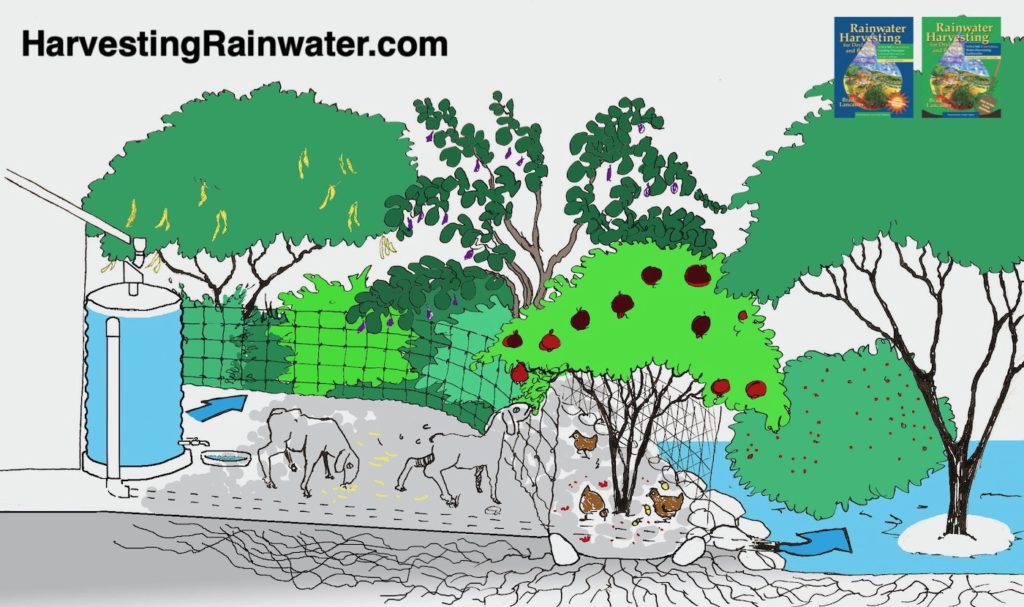
Reproduced with permission from “Rainwater Harvesting for Drylands and Beyond, Volume 2, 2nd Edition”
Plant the following GOOD plants — especially those native to your area — within or beside water-harvesting earthworks around your goat pen and along your goat walks.
And bring the prunings from the following GOOD plants to your goats.
Caution: Plants in red appear on both GOOD and BAD/POISONOUS lists.
BAD/POISONOUS plants are listed lower down, after the lists of GOOD ones.
Contact your local agriculture cooperative extension office for more information and help with plant identification.
Disclaimer:
This list is a work in progress. I am just beginning my goat learning, having only recently (11-2020) acquired a couple of Nigerian dwarf goats. Keep in mind that plants can vary in subspecies, variety, and or chemical make up based on what bioregion, soils, or climate they grow in.
Note: that plants referenced from interviews emphasize plants that grow in the southwest U.S. and northern Mexico (Sonoran and Chihuahuan deserts and bordering grasslands)
Please note, you’ll see that a number of plants appear on both the GOOD and BAD lists. For example, I’ve found Nigerian dwarf goats I’ve walked in public parks in Tucson love spurge, and will eat it instead of the grass. But the book “City Goats” reports that it is toxic to goats. While the Oregon State University newsroom article, “Dogs love trucks, goats love leafy spurge” by Randy Dovel, says spurge is fine for goats.
So, when in doubt, avoid the plant in question, or experiment with cautious moderation.
And always introduce new foods to your goats in small amounts, then slowly increase if all is good, so their rumens can adapt.
Plants browsed in the wild vs. plants available in confinement:
Confined goat spaces such as pens or fenced pasture must be monitored and managed to ensure they are healthy and safe, and do not contain potentially toxic plants that could be overeaten.
For example, a goat browsing in the wild could likely take a medicinal bite of datura and move on with no problem, but I’d never feed it to goats in their pen where they could likely eat too much if their non-toxic feed options run low.
Check back periodically, as I plan update this list as I learn more.
GOOD plants for goats
GOOD native perennial plants Brad Lancaster has found his goats like to eat
GOOD Tucson Basin/Sonoran Desert native TREES for goats
• Cat claw acacia (Senegalia greggii) acacia leaves and seeds – a favorite
• Canyon hackberry (Celtis reticulata)
• Desert ironwood (Olneya tesota) leaves–especially in winter when other plants are dormant/deciduous; flowers (fresh or dried); and seeds – a favorite
• Mesquite (Prosopis velutina & Prosopis pubescens) pods – a favorite, hard sap, leaves, and flowers
• Palo verde (Parkinsonia microphyllum & Parkinsonia floridum) leaves and flowers (fresh or dried)
• White thorn acacia (Vachellia constricta) leaves
GOOD higher elevation southern-Arizona native TREES for goats
• Emory oak (Quercus emoryi) – acorns, leaves
GOOD TREES native to Chihuahuan Desert for goats
• Texas ebony (Ebenopsis ebano)
GOOD Tucson Basin/Sonoran Desert native SHRUBS for goats
• Brittlebush (Encelia farinosa)
• Chuparosa (Justicia californica)
• Condalia (Condalia warnockii) – a favorite
• Creosote (Larrea tridentata) – they like new growth and dried leaves
• Desert hackberry (Celtis pallida)
• Desert broom (Baccharis sarothroides)
• Fairy duster (Calliandra eriophylla) – a favorite
• Four-wing saltbush (Atriplex canenscens)
• Globemallow (Sphaeralcea ambigua) – a winter favorite
• Jojoba (Simmondsia chinensis) leaves (especially in winter when other plants are dormant/deciduous) and nuts – a favorite
• Mormon tea (Ephedra trifurca)
• Quail bush (Atriplex lentiformis) – a favorite
• Triangle-leaf bursage (Ambrosia deltoidea)
• Wolfberry (Lycium spp.)
GOOD higher elevation southern-Arizona native SHRUBS for goats
• Little-leaf sumac (Rhus microphylla) – a favorite
• Manzanita (Arctostaphylos spp.)
GOOD SHRUBS native to Chihuahuan Desert for goats
• Mexican bird of paradise (Caesalpinia mexicana)
• Hesperaloe (Hesperloe parviflora) – they like the flowers
GOOD Sonoran Desert native VINES for goats
• Old man’s beard, barbas de chivo (Clematis drummondii)
• Snapdragon vine (Maurandya antirrhiniflora)
GOOD Tucson Basin/Sonoran Desert native CACTI for goats
• Barrel cactus (Ferocactus wislizenii) – fruit
GOOD Tucson Basin/Sonoran Desert native annual plants Brad Lancaster has found his goats like to eat
• Amaranth (Amaranthus spp.) – greens and seed
• Portulaca, Purslane (Portulaca spp.)
• Red spiderling (Boerhavia erecta and Boerhavia intermedia)
For info on how we plant and prune native community food forests see: www.DunbarSpringNeighborhoodForesters.org
Non-native invasive plants Brad Lancaster has found his goats like to eat
Due to their invasive nature, I would not plant these following plants in the Sonoran Desert, but if they are already there, they make good browse for the goats, and the goats can help check the spread of these non-natives.
• African sumac (Rhus lancea)
• Bermuda grass (Cynodon dactylon)
• Little mallow, cheeseweed (Malva parviflora)
• River tamarind (Leucaena leucocephala)
• Southwest sweet acacia (Vachellia farnesiana)
• Tamarisk
• Tumbleweed (Salsola tragus)
GOOD domesticated plants & kitchen scraps Brad Lancaster has found his goats like to eat
• Aloe
• Banana peels (I make sure I only give them peels from organically-grown bananas, since the pesticides applied to conventional bananas can be toxic). Cut up in 1 – 2 inch pieces as they are easier for them to eat that way.
• Bougainvillea (leaves and flowers)
• Carrot tops
• Citrus tree leaves
• Edible greens (lettuce, kale, chard, mustards, etc) from the vegetable garden
• Nopal cactus (Opuntia ficus-indica) pads (I cut them up into 1/2-inch to 1-inch cubes)
• Oak tree leaves (though I always make sure the goats have other forage as well, so oak leaves are not the only thing they get) and acorns
• Orange peels (I make sure I only give them organic, non-waxed peels – most easily attained from my own tree and other neighborhood or local growers) and orange tree leaves
• Pomegranate (fruit and peel/skin)
• Queens wreath (Antigonon leptopus) vine – leaves
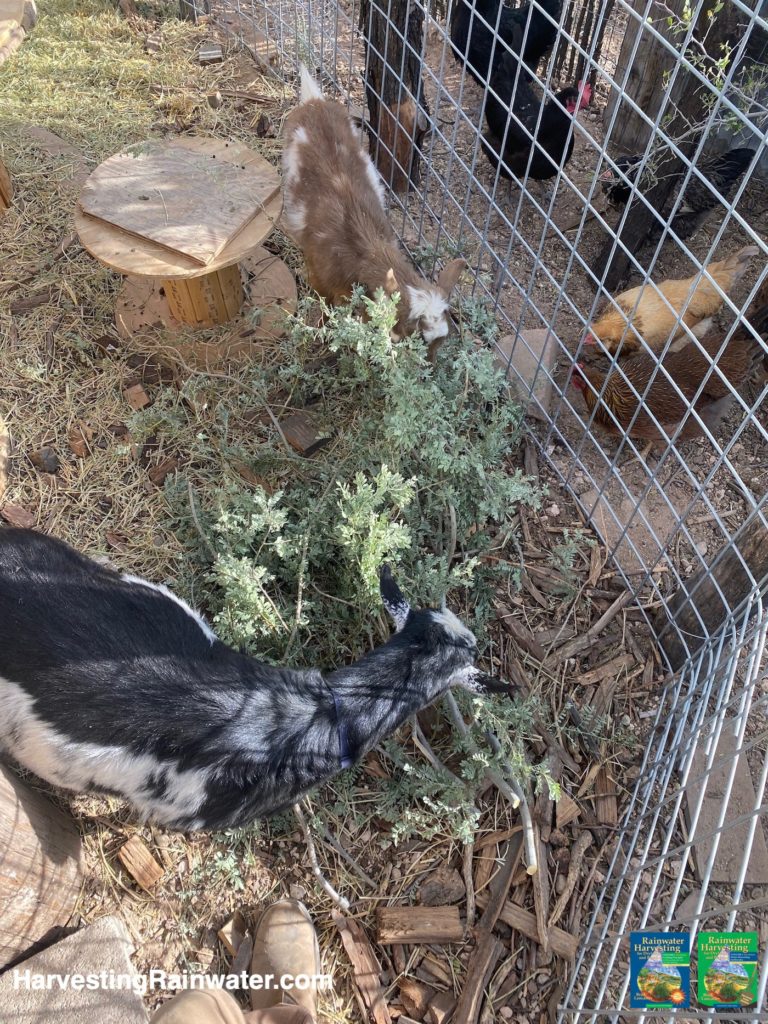
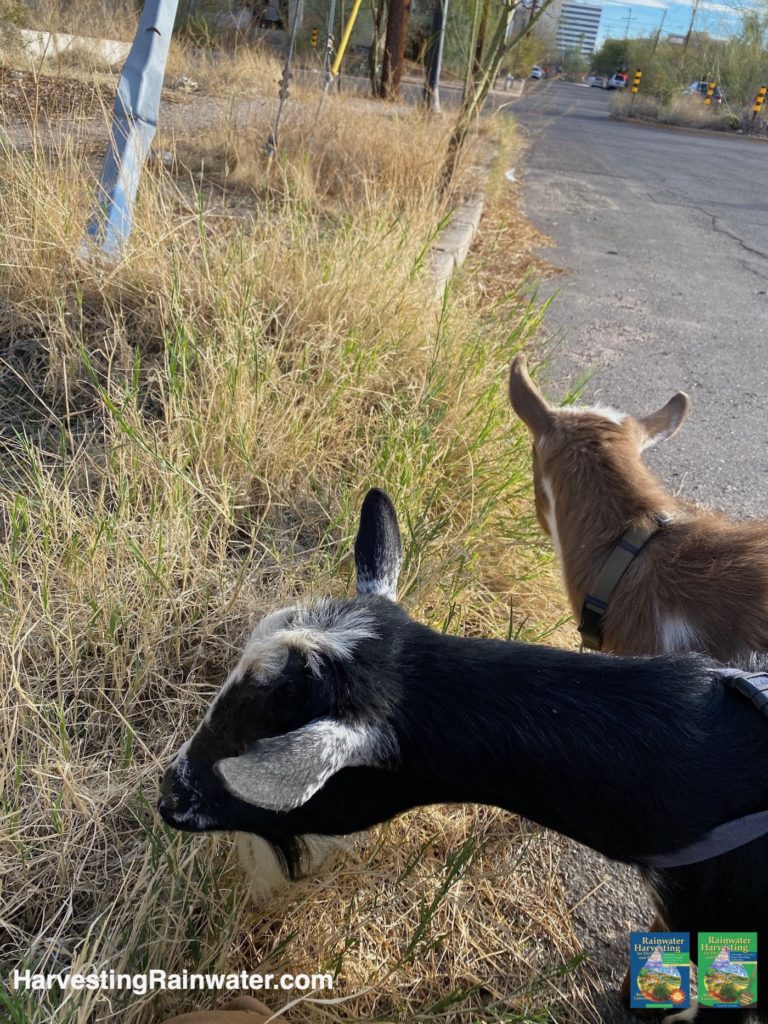
GOOD plants for goats
—notes from 7-30-20 phone conversation with Barbara Clark, long-time goat keeper in Cascabel, Arizona
Caution: Plants in red appear on both GOOD and BAD/POISONOUS lists.
Goats like:
• Bermuda grass
• Johnson grass
• Grasses – all
They need the woody stuff and they like:
• Cat claw acacia
• Cottonwood
• Datura (maybe just in medicinal amounts)
• Desert willow
• Mexican Elderberry
• Foresteria neomexicana? Desert Olive
• Little leaf sumac
• Mesquite – rake up pods dry (before rains arrive – to avoid aflatoxins), dry out if needed, and store them dry in garbage can to last longer into the season.
• Saltbush
• Tamarisk
• Willow
• Wolfberry
GOOD plants for goats
from the book “Goatwalking” by Jim Corbett, Penguin Books, 1991
Caution: Plants in red appear on both GOOD and BAD/POISONOUS lists.
• Wild mustard
• Filaree
• Patata
• Cat claw acacia
• Desert ironwood
• Cholla fruit
GOOD plants for goats
from the book, “Raising Dairy Goats, 5th Edition” by Jerry Belanger and Sara Thomson Bredesan, Storey Press, 2018
Good weeds for goats:
Caution: Plants in red appear on both GOOD and BAD/POISONOUS lists.
- chicory
- daisy
- dandelion
- multiflora rose
- nettle
- plantain
- thistle
- yarrow
GOOD plants for goats
from the book “City Goats”
Caution: Plants in red appear on both GOOD and BAD/POISONOUS lists.
- blackberries
- fresh grass (all varieties)
- clover
- dandelions
- kudzu
- apple leaves
- maple leaves
- roses (hips, leaves, and flowers)
- Fresh vegetables, especially carrots (but NOT potato tops or tomato plants)
More GOOD and BAD plants for goats can be found at:
https://fiascofarm.com/goats/poisonousplants.htm:
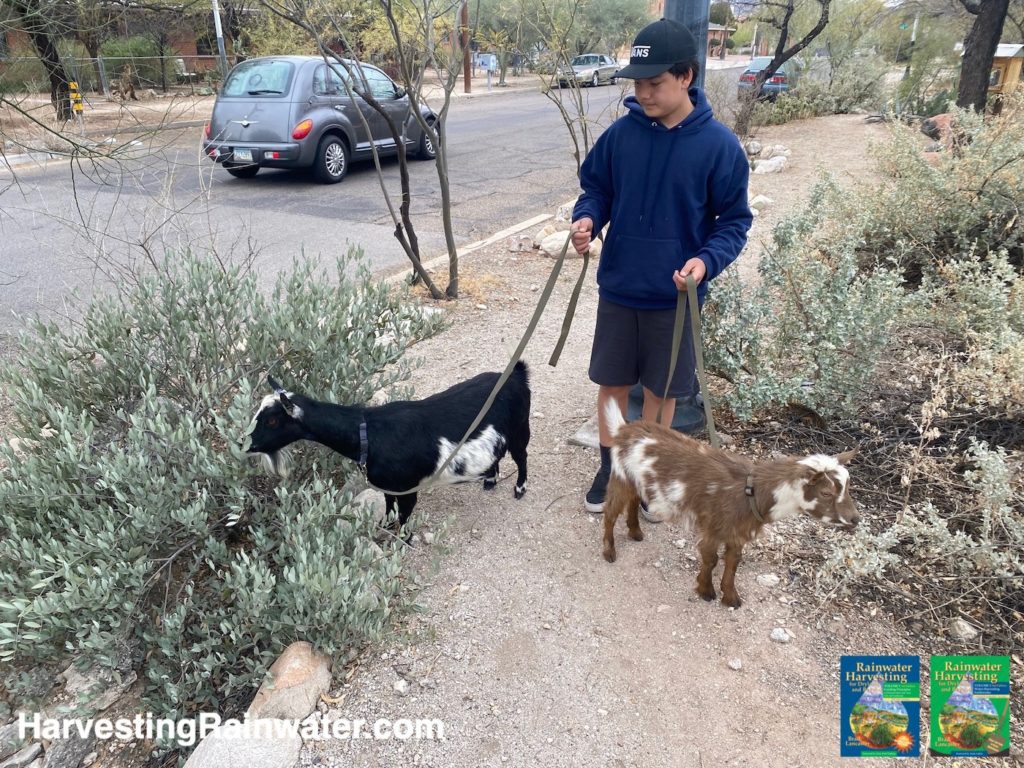
BAD / POISONOUS plants for goats
Compiled by Brad Lancaster from listed sources below
Note: Plants in red appear on both GOOD and BAD/POISONOUS lists
BAD / POISONOUS plants for goats
6-29-20 notes from Anastasia Rabin, goat keeper in Elfrida, AZ:
Bad/poisonous garden plants:
- all alliums – garlic, onions
- avocados
- beet leaves
- rhubarb
- horseradish
- tomato/potato – vines and leaves
- elderberry
- peach, apricots, plum, cherry – especially the leaves
- poinsetta
Bad/poisonous landscape/wild plants:
- Astragalus
- Beargrass
- Broom snakeweed
- Burroweed
- Cat claw acacia – after frost
- Chinaberry
- Cocklebur
- Datura
- Delphinium/Larkspur
- Goatheads
- Horse nettle
- Ivy
- Johnson Grass (after frost)
- Lantana
- Lupine
- Milkweed
- Morning Glory
- Nightshades
- Oleander
- Paperflower
- Privet
- Sweet pea
- Tree tobacco
- White thorn acacia – after frost
BAD / POISONOUS plants for goats
from the book “Raising Diary Goats, 5th Edition” by Jerry Belanger and Sara Thomson Bredesan, Storey Press, 2018
Bad weeds for goats:
Note: Plants in red appear on both GOOD and BAD/POISONOUS lists
• bracken fern
• dock
• hemlock
• locoweed
• milkweed
• mountain laurel
• oak leaf
• rhubarb
• sorrel
• wilted wild cherry
Nitrate poisoning is possible from some “good” plants if they undergo chemical changes due to weather.
As stated in “Raising Dairy Goats”, “Sudan grass, johnson grass, pigweed (amaranth), lamb’s quarters, alfalfa, corn, and oats can accumulate toxic amounts of nitrates if they undergo rapid growth after a dry spell.”
BAD / POISONOUS plants for goats
from the book “City Goats” by Jennie P. Grant, Skipstone, 2012
Bad/poisonous plants for goats:
Note: Plants in red appear on both GOOD and BAD/POISONOUS lists
• Azalea
• Buttercup
• Bracken fern
• Cherry tree
• Common milkweed
• Daphne
• Elderberry
• Foxglove
• Hemlock
• Lantana
• Laurel
• Lily of the valley
• Locoweed
• Lupine
• Oak tree
• Plum tree
• Poison Ivy
• Pokeweed
• Poppy
• Potato
• Rhodeodendron
• Rhubarb
• Spurge
• St. John’s Wort
• Tobacco
Click here for a list of Sonoran Desert plants for chickens.
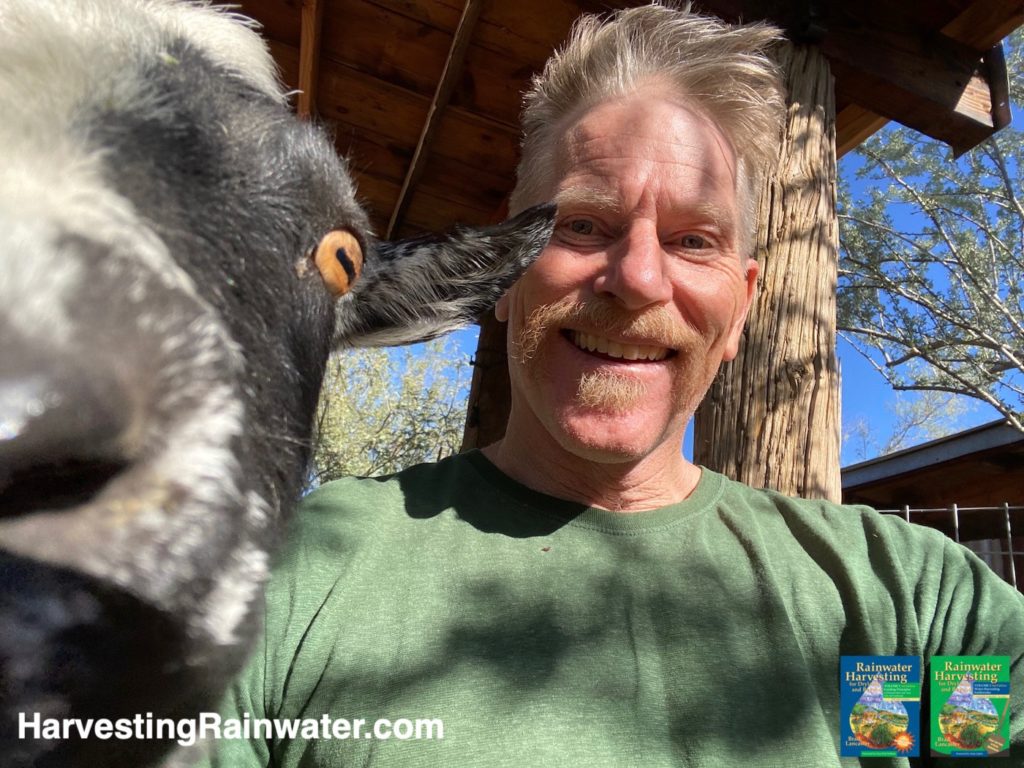
For great info on
• how to irrigate these plants with free, on-site waters;
• how to effectively place these plants to shade/cool goats, other livestock, homes, and gardens in summer,
• how to place these plants to warm goats, homes, and gardens in winter
• and more…
See the new, full-color, revised editions of Brad’s award-winning books
Rainwater Harvesting for Drylands and Beyond, Volume 1, 3rd Edition
and
Rainwater Harvesting for Drylands and Beyond, Volume 2, 2nd Edition.
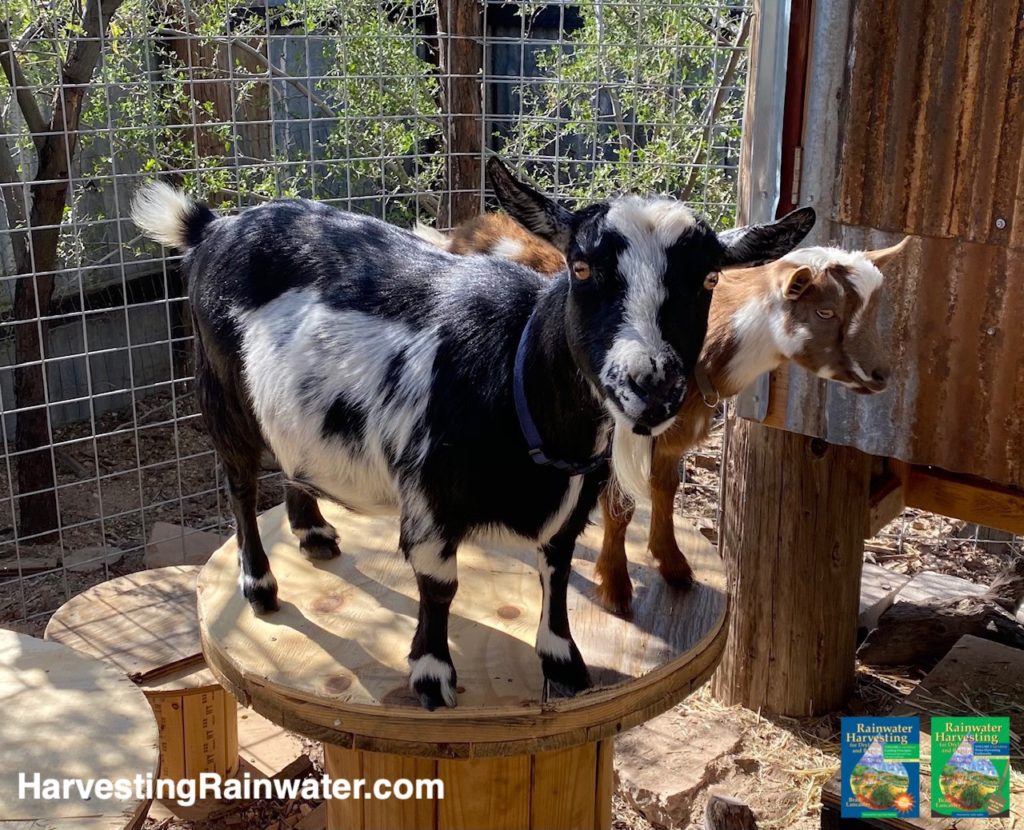
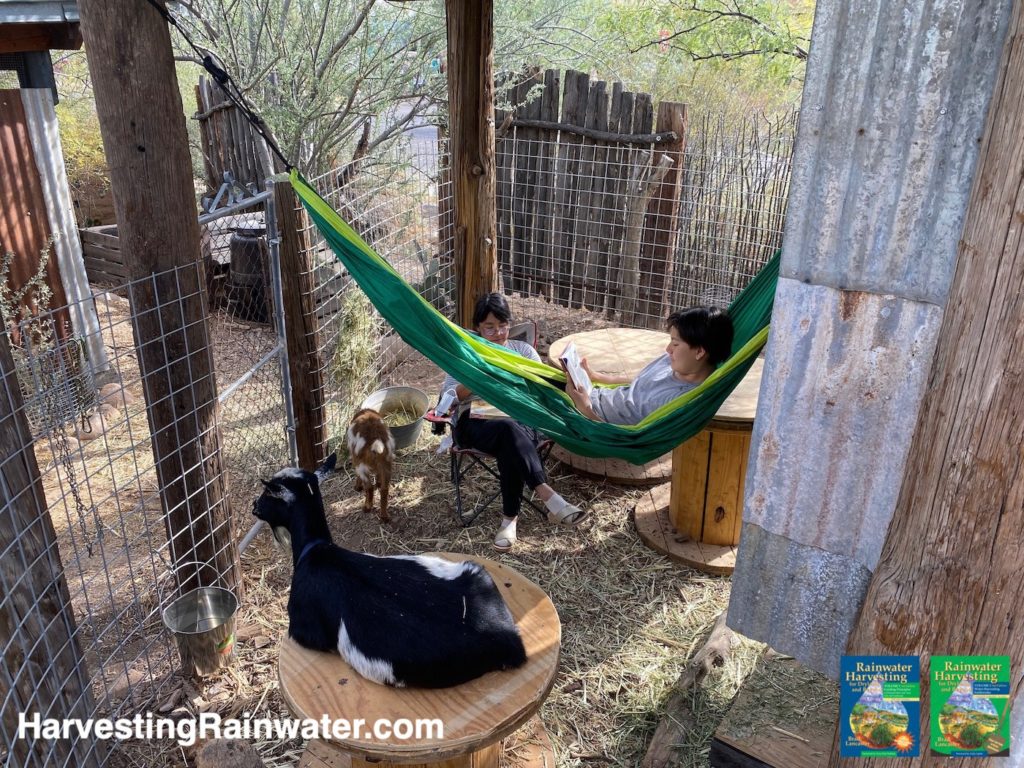

Volume 1

